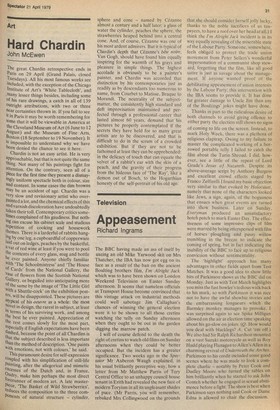Art
Hard Chardin
John McEwen
The great Chardin retrospective ends in Paris on 29 April (Grand Palais, closed Tuesdays). All his most famous works are included, with the exception of the Chicago Institute of Art's 'White Tablecloth', and .many lesser things besides, including some of his rare drawings, a catch in all of 139 outright attributions, with two or three n. ear certainties thrown in. If you fail to see it in Paris it may be worth remembering for some that it will be viewable in America at the Cleveland Museum of Art (6 June to 12 August) and the Museum of Fine Arts, 13. oston (18 September to 19 November). It Is impossible to understand why we have been denied the chance to see it here.
Chardin is not an easy artist. He is very approachable, but that is not quite the same thing. Not many of his paintings fight for attention. On the contrary, seen all of a Piece for the first time they present a dismayingly uniform spectacle both in colour, size and content. In some cases the dim browns may be an accident of age. Chardin was a vetY slow and revisionary artist who overPainted a lot, and the chemical effects of this and varnish discoloration have undoubtedly taken their toll. Contemporary critics some1m es complained of his gaudiness. But nothing can excuse his cabinet scale and studious rePetitionof cooking and housework themes. There is a larderful of rabbits hanging by one leg, a cupboardful of copperware laid out on ledges, peaches by the basketful, a vat of red wine at least if you were to pool the contents of every glass, mug and bottle he ever painted. Anyone chiefly familiar With 'The Schoolmistress' and 'The House Of Cards' from the National Gallery, the vase of flowers from the Scottish National Gallery, or beguiled into anticipating more of the same by the image of 'The Little Girl With a Shuttle-cock' on the exhibition posters, will be disappointed. These pictures are atypical of his oeuvre as a whole: the most ovel in design, the rarest in subject, at least in terms of his surviving work, and among the best he ever painted. Appreciation of the rest comes slowly for the most part, especially if English expectations have been dashed, because the point of all Chardins is that the subject described is less important than the method of description. 'One paints with emotions, not with colours,' he said.
This paramount desire for self-expression Coupled with his simplification of still-life Painting, after the allegorical and mimetic excesses of the Dutch and, in France, °LidrY, make him perhaps the most direct forerunner of modern art. A late masterpiece, 'The Basket of Wild Strawberries', reduces the composition to the three comPonents of natural structure — cylinder, sphere and cone — named by Cezanne almost a century and a half later: a glass of water the cylinder, peaches the sphere, the strawberries heaped behind into a central cone. And, of course, Cezanne was one of his most ardent admirers. But it is typical of Chardin's depth that Cezanne's bete noire, Van Gogh, should have found him equally inspiring for the warmth of his grays and pleasure in simple things. The highest accolade is obviously to be a painter's painter, and Chardin was accorded that distinction by his contemporaries just as readily as by descendants too numerous to name, from Courbet to Matisse, Braque to Morandi. The neutrality of the subjectmatter, the consistently high standard and deft improvisation maintained and perfected through a professional -career that lasted almost 60 years, demand that his pictures be properly contemplated if the secrets they have held for so many great artists are to be discovered, and that is difficult to do in the scrum of a crowded exhibition. But if they are not to be fathomed at least they can be apprehended: in the delicacy of touch that can equate the velvet of a rabbit's ear with the skin of a peach, and the gravity of their progress from the hideous face of 'The Ray', like a demon out of Bosch, to the Hogarthian honesty of the self-portrait of his old age.






































 Previous page
Previous page